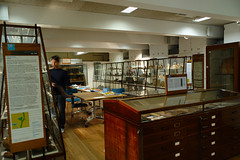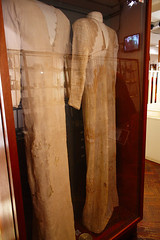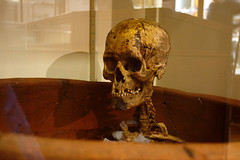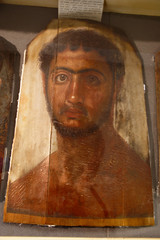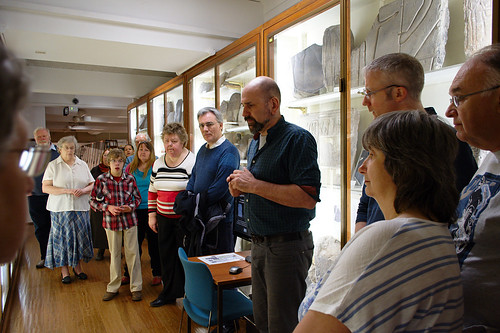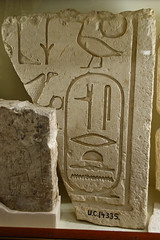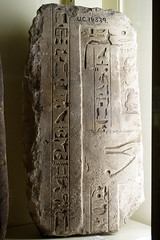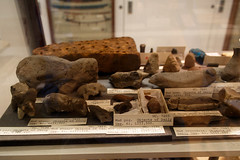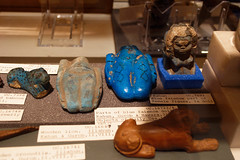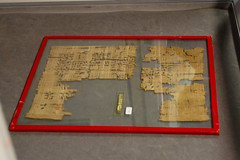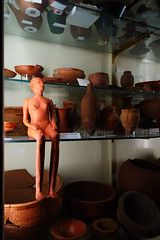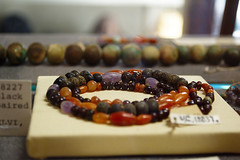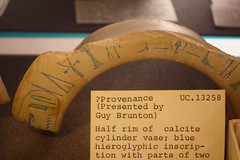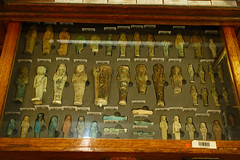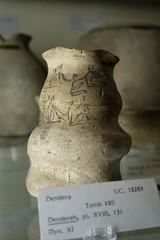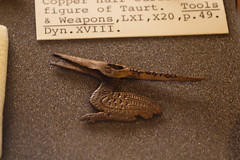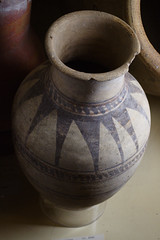On Saturday about 20 of us from the Essex Egyptology Group went to the Petrie Museum for a tour. We were shown round first by Tracey Golding, the Visitors Services Officer, who gave us an introduction to the museum. It is part of UCL and was founded to house the collection of items that Petrie dug up in his excavations in Egypt. There are 80,000 objects in the collection, of which about 10% are on display. To fit everything into the relatively small space that they have in the museum (about a quarter to a third of the space is shown in the first photo below) the cases are very full and the labels are pretty minimal. However every item is numbered and you can look them all up on the museum website and learn more about it. Golding pointed out some of the highlights of the collection including some dresses, an ancient pot burial and the selection of their large collection of mummy portraits that are out on display.
Then she handed us over to Wolfram Grajetzki who talked to us about Lahun – an ancient village & pyramid complex in the Faiyum region of Egypt which was excavated by Petrie twice, once in the late 1880s and again in the 1910s. The pyramid at Lahun belongs to the Pharaoh Senusret II who was part of the 12th Dynasty, so part of the Middle Kingdom era of Egyptian history. The Middle Kingdom was regarded as a “classical era” by later Egyptians in the New Kingdom, but there are few surviving buildings or inscriptions from this era. Grajetzki said this was because the stone that built the Middle Kingdom structures was often re-used during the New Kingdom because it was of good quality. And it’s a lot easier to re-use already cut limestone blocks rather than cut and transport new ones from the quarries.
The pyramid at Lahun was built of mud brick, with stone lined rooms inside and an outer casing of limestone. Almost all of the outer casing has been removed, so if you visit there today you see the remains of the mudbrick structure. He showed us a piece of the casing that was discovered by Petrie – a fragment with a cartouche containing the name Senusret (first photo below). Grajetzki used this to illustrate the importance of knowing the provenance of an item – if this had been acquired via the art markets with no idea where it was found then there’d be no way of knowing which Senusret it referred to. However as it was found next to the pyramid of Senusret II they can be reasonably sure that it’s this Senusret that’s named. The pyramid and the tombs of nobles nearby show signs of attempts to stop tomb robbery. The entrance to the pyramid isn’t where you would expect it to be from earlier pyramids (however the tomb was still robbed in antiquity). And the nobles tombs are separated from their tomb chapels – previously you’d expect the burial chamber to be immediately beneath the decorated chapels, but here they are on different sides of the pyramid entirely. Grajetzki showed us a fragment from a false door stela (second photo below) that was (I think) from one of these noble’s tomb chapels – it is for a man called Inpy who might be the architect of the pyramid (but might not, that’s an extrapolation from his titles).
Grajetzki went on to tell us about the town at Lahun – he said that the site was occupied during most of Egyptian history but it flourished during the Middle Kingdom in the reign of Senusret II and just afterwards. At first during this era it was the home of the pyramid builders and then the people who staffed the pyramid temple after Senusret II’s death. There is evidence that another nearby pyramid (that of Amenemhat III, I think he said) was built by workers from this village after they’d finished Senusret II’s pyramid. Grajetzki told us that there hasn’t always been a lot of archaeology done on villages & towns in Egypt – he was saying this is because it’s easier and more exciting to clear away the sand from a temple and find inscriptions and maybe even beautiful artifacts. But that doesn’t tell you about the ordinary people, for that you need to do the sort of painstaking sifting through a site that’s all that you can do in other places that don’t have the sorts of tempting temples & tombs that Egypt has.
But Petrie did excavate the town, and in so doing found a lot of everyday objects used by the Egyptians of this time. As well as tools and pots there are other objects with less obvious uses. These are not as high quality as the objects found in high status tombs, but often they’re the same sorts of objects so this can broaden our knowledge of what their purpose was. And one of Grajetzki’s themes for this part of his talk was that often we don’t know what things are or what they were used for, we can only speculate. He showed us several small clay model animals (first picture below) which are similar to fine faience hippos that have been found in tombs. Archaeologists have speculated that these are so that the deceased can ritually kill evil (as incarnated by the hippo) in the afterlife and keep themselves safe – but clearly this can’t be why the houses excavated in Lahun contained these less well made clay animals (not just hippos but several different animals). Ornaments? Some sort of ritual purpose? He also showed us some small faience figurines, of women cut off at the knee. On their thighs they have diamond marks, and there are evidence of tattoos in this pattern on some female mummies. Early archaeologists speculated that these were concubines for the deceased with no legs so that they couldn’t run away!! In Lahun there were also low quality versions of these figurines found in the houses. So again it can’t just be “provides X for the deceased” as their purpose, were they dolls? Ornaments? Ritual things? We can’t tell.
Grajetzki then went on to show us some of the things to do with Lahun that are shut up in the cupboards rather than being on display. One of these things (I don’t have a photo) was a drawer of wooden slats that had made up a baby’s coffin. Petrie discovered several infants buried in the floors of the houses of Lahun in simple wooden coffins. Grajetzki was speculating that perhaps due to the high infant mortality rate of the time infants who hadn’t yet learnt to speak might’ve been regarded as not yet human enough to require a proper burial in the nearby cemetery. One of the other major finds at Lahun was a lot of papyri (third photo, immediately above, is an example) – both scattered through the town and a collection in a building at the edge of the town. The scattered stuff was the bits & pieces that the population had used, and the collection was an archive (of the pyramid temple, I think he said?). Most of the papyri related to the last period of the Middle Kingdom inhabitance of Lahun, because papyrus was often reused by washing the ink off and starting again. It’s from these papyri that they know that the builders of the further away pyramid also lived at Lahun.
It was a very interesting talk – he’s a good speaker, and I always find it fascinating to hear about the things that we don’t know all the answers about. After the talk we all hung around for a while looking at other things that caught our eyes. There’s always something else to look at in the museum, even if you’ve been several times (I’ve only been the once before though).
J & I then went off for lunch (at Wagamama’s) before coming back to the museum for another couple of hours. I mostly wandered through taking pictures of things I liked the look of, I think J was a bit more systematic. My photos are up on flickr here, and a few of my favourites are below:
